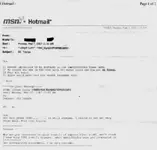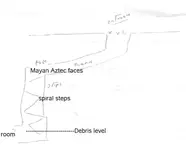Dear group;
There is one nagging question which occurs with alarming regularity in regards to the lost treasures of Tayopa and Naranjal. This is the appalling lack of factual documentation supporting the claims. Virtually every shred of evidence can be picked clean and exposed with the most basic and cursory examination. For instance, I read this allegded *mainifest* of the lost treasures of Tayopa and I honestly could not stop laughing. Here it is, in entirety:
Four bells inscribed TAYOPA. ?Weight 727 lbs.
One bell inscribed REMEDIOS. Weight 285 lbs.
One bell inscribed PIEDAD. ?Weight 125 ?lbs.
These bells were cast in 1603 by the Right Rverend Father Ignacio Maria de Retana.
One silver cross with gold crucifix. ?Weight 40 lbs.
Pair of candlesticks and six bars of silver. Weight 113 lbs.
Four incensories of gold and silver. Weight 28 lbs.
One large custody with silver bracket. ?Weight 25 lbs.
Two silver chalices and twelve gold communion plates.
One shrine with four silver columns. Weight 100 lbs.
Sixty-five cargas of silver. ?Weight 14,000 lbs.
Eleven cargas of gold. Weight 2475 lbs.
Casilla ore. ?Weight 4575 lbs.
First-class Castilla ore with a known assay of 22 carats, clean and without mercury. ?Weight 1625 lbs.
In a cut stone box are stored jewels. ?The box is buried in the basement of a room built of stone and mud between the church and the side of the convent and fruit garden."
"A true and positive description of the mining camp Real of our Lady of Guadelupe of Tayopa, made in January 1646 by the Right Reverend Father Guardian Fray, Fransisco Villegas y Orosco, Royal Vicar-General of the Royal and Distinguished Jesuit Order of St. Ignacio of Tayopa, and Jesuit of the Great Faculty of Sonora and Biscalla, whom may God keep long years.
As a group of dedicated researchers, we can dismiss this document without having to leave our desks. First, we have 4 bells, inscribed Tayopa, which are missing. Hmmmm, I doubt this very much. Bells were never *inscribed* with anything, as inscriptions tend to weaken the casting and over time the bell can very easily crack anywhere along the surface where there may be a flaw. This would include inscriptions. Words, dedications and such were cast into bells and this wasn't commonplace for chapels and cathedrals.
OK, so now we know that these bells were in 1603 by the
Right reverend
Father Ignacio Maria de Retana

I have never once been confused with Albert Einstein, but when in Gods' name did Roman Catholics start placing Anglican religious titles in front of the names of its' priests

Right reverend

Was dear Fr. Ignacio Maria de Retana a Protestant before converting to Catholism? Or, perhaps he was a Catholic and then converted to Protestanism? This is absolutely hilarious, gentlemen. There is no such animal as a Right Reverend Father! You are either Father Such & Such (Catholic) or the Right Reverend Such & Such (Anglican).
At least we now have some names, even if the actual title is a complete fabrication so now we continue onward from this point. Research into the names of the Retana and Fray turn up nothing. So, unless they were members of the *secret* Jesuit Society, then we can conclude that these names are pure fabrication. Secret Jesuit Society? Sure, they were the ones whom, after expending all of that time, effort and labor digging up all of the gold & silver then thought it was prudent to re-distribute it back into the very ground from which it came, only in completely different locations. That they managed to do all of this without having been seen even once and recorded must be the conspiracy of all time.
Royal Vicar-General of the Royal and Distinguished Jesuit Order of St. Ignacio of Tayopa, and Jesuit of the Great Faculty of Sonora and Biscalla, whom may God keep long years.
Now we have a title and it is pretty impressive, to say the least. There is only one small problem with it. The Jesuits have never used the name of their patron saint, St. Ignacio for any other place than where he was born, Loyola. His full title is St. Ignacio of Loyola and nothing else. His name is not associated with any other place name, such as Sta. Maria Virgen de Guadalupe. If one were to look closely, then one would see the letter Y between the names Villegas and Orosco. These names were never linked with the Y (It means AND in Spanish) and they were instead linked with either a plain dash as Villagas-Orosco, or else they were simply spelt as Villagas Orosco.
Next, continuing to look at the *title* we see that the Jesuits where granted a title and a very regal sounding one at that!
Royal and Distinguished Jesuit Order of St. Ignacio of Tayopa, and Jesuit of the Great Faculty of Sonora and Biscalla
Unfortunate as it may seem, the Jesuits have always been known simply as the Society of Jesus, and in fact that is all they can be known as, for they have no royal affliations. The *Royal and Distinguished Jesuit Order of St. Ignacio of Tayopa* sounds like a fraternal organization, the Moose Lodge or something.
Marching on, we come to:
First-class Castilla ore with a known assay of 22 carats, clean and without mercury. ?Weight 1625 lbs.
I should hope the gold was clean and without mercury,since the amalgamation process of gold to mercury was unheard until the 17th century. Mercury was used to amalgam with silver during this time period, my friends.
The accompanying photos show someone standing proudly before a pair of 18th century lime kilns. The limestone blocks are clearly strewn about and the supporting evidence suggests that these kilns did not even come into existence until the 1800s. Dring the 15th and 16th centuries beehive kilns were in use and the *stacked* or *tiered* kilns didn't come into use until much later.
It seems that in order to fill in some of the glaring holes in these undocumented myths, *experts* feel the need to plug some of the gaps in history with their own fabricated documentation. While they are amusing, in the end these *documents* make actual research much more difficult, as there are a great many people who choose to believe these *professionals* and as such, through their years of dedicated searching, tend to make life more difficult for actual researchers. If I were to research the missions in the vicinity of Tayopa, without a doubt the locals would think "Oh Lord, here's another one looking for lost treasure."
This is exactly the same as the researcher who proclaimed to have discovered Paititi. Of course, the reason why it hadn't been discovered sooner is because it's entirely underground, with huge caverns, connected by tunnels. Of course! Why didn't I think of that? Also, seeing as how the Inca nation wasn't in existence for 200 years before the first European set foot in South America, and taking into account that the Incas had not yet progressed to a metal tool stage, how did they manage to cut all of those tunnels in such a short period of time?
The one incontroversial truth about documented evidence is that it stands the "How, when, what, why and where" test, all of the time, every time. One neat little theory is that the Jesuits had a *secret Jesuit Society*. OK, fine. There was a secret society which has remained undetected for over five centuries. This was during a time when a man couldn't perform simple mathmatical calculations, jump in a boat and find his way to India! Columbus was a half of a world off in his calculations, yet during this same time there existed a shadow society, cloaked in secrecy? They were still burning people at the stake for owning a deck of Tarot cards, yet I am to believe that someone would risk the pyre for reasons unknown?
Your friend;
LAMAR





 ?
?


